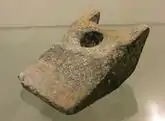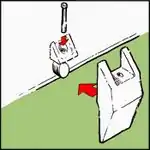Wedge of Aiud
The Wedge of Aiud (Romanian: călcâiul din aluminiu de la Aiud or obiectul din aluminiu de la Aiud) is one of those supposedly "mysterious" out-of-place artifacts. It was found in Aiud, Romania in 1974.[1]

| Fiction over fact Pseudohistory |
| How it didn't happen |
v - t - e |
Details are hard to verify, but the 4 to 5 pound wedge-shaped aluminum object was allegedly found during digging on a construction project, along with two mastodon bones in 35 feet of sand. Someone gave it to the Museum of History of Transylvania, where it lay ignored in a storeroom for 20 years, before editors from a Romanian UFO magazine found it in 1995.[1] (It's not clear why UFO enthusiasts were poking around a national museum storeroom. Maybe that's just how they do things in Transylvania.)
Based on it being found in the same layer as the mastodon bones, the wedge is claimed to be at least 11,000 years old, if not millions.[2]
Aluminum
The fact that this wedge-shaped thing is made from aluminum gets some people very excited because, prior to 1825, metallic aluminum effectively did not exist.[3] And the first exciting explanation they come up with is (you guessed it) aliens.
Yes, according to some unnamed engineer, the wedge is a piece of the landing gear from a VTOL-type (Vertical Take-Off and Landing) craft. This, of course, delights UFOlogists, who say an alien starship must have lost it when they blasted off after a visit to Earth thousands of years ago.[4]
Fantasy buffs speculate that it's something left behind by a time traveler making a hasty retreat from attacking mastodons, or partying with a band of early humans at the barbecue where the mastodon dropped.[3][5]
Spoil-sport skepticism

Yet, there's a much more rational (albeit boring) explanation. The wedge is simply a tooth from a modern day excavator bucket, the kind used by workers digging foundations for construction projects.[6]
The results of metallurgical tests made on the wedge are somewhat consistent with modern 2000 series duralumin
Aluminum will not strike sparks as steel might, which makes the alloy desirable for service in environments with combustible gases or vapors, such as the coal mines that flourished for a while in Romania.[3]
With a decline in coal mining, the excavators may be reasonably supposed to have been turned to other uses. It's extremely likely that one of these excavators lost a tooth while digging the hole in Aiud; someone unfamiliar with the machine found it in the sand near the mastodon bones, and assumed it to be an anachronism.[3]
See many examples of excavator teeth, here, a number of which closely resemble the so-called "out-of-place" artifact.[3]
See also
References
- Leonardo Vintini The Aluminum Artifact of Aiud, Romania Epoch Times, March 2009
- Unexplained Mysteries When looking for proof of ancient aliens look no further than the Wedge of Aiud! coolinterestingstuff.com
- Debunking Wedge of Aiud and other random aluminum from the past" Aluminum, Aliens (1): What "THEY" left Behind in Aiud Hil Blairious
- Aluminum, Aliens (2): The BBC Hil Blairious
- John Lear Object Made of Aluminum from Aiud thelivingmoon.com
- Aluminum, Aliens (3):An Example For Debunkers Hil Blairious
- See the Wikipedia article on Duralumin..